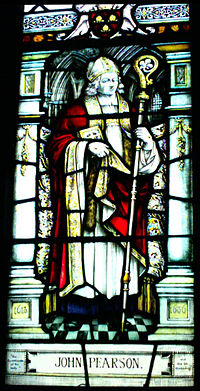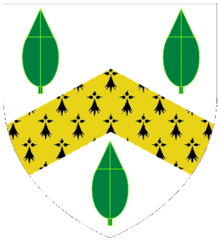For other people named John Pearson, see John Pearson (disambiguation).



John Pearson (28 February 1613 – 16 July 1686) was an English theologian and scholar.
Life
He was born at Great Snoring, Norfolk.
From Eton College he passed to Queens' College, Cambridge, and was elected a scholar of King's College, Cambridge in April 1632, and a fellow in 1634. On taking orders in 1639 he was collated to the Salisbury prebend of Nether-Avon. In 1640 he was appointed chaplain to the lord-keeper Finch, by whom he was presented to the living of Thorington in Suffolk. In the Civil War he acted as chaplain to George Goring's forces in the west. In 1654 he was made weekly preacher at St Clement's, Eastcheap, in London.
With Peter Gunning he disputed against two Roman Catholics, John Spenser and John Lenthall, on the subject of schism, a one-sided account of which was printed in Paris by one of the Roman Catholic disputants, under the title Scisme Unmask't (1658). Pearson also argued against the Puritan party, and was much interested in Brian Walton's polyglot Bible. In 1659 he published in London his celebrated Exposition of the Creed, dedicated to his parishioners of St Clement's, Eastcheap, to whom the substance of the work had been preached several years before. For example, in relation to the Christian cross, he wrote in his commentary on the Apostles' Creed that the Greek word stauros originally signified "a straight standing Stake, Pale, or Palisador", but that, "when other transverse or prominent parts were added in a perfect Cross, it retained still the Original Name", and he declared: "The Form then of the Cross on which our Saviour suffered was not a simple, but a compounded, Figure, according to the Custom of the Romans, by whose Procurator he was condemned to die. In which there was not only a straight and erected piece of Wood fixed in the Earth, but also a transverse Beam fastned unto that towards the top thereof".
Soon after the Restoration he was presented by Juxon, Bishop of London, to the rectory of St Christopher-le-Stocks; and in 1660 he was created doctor of divinity at Cambridge, appointed a royal chaplain, prebendary of Ely, archdeacon of Surrey, and Master of Jesus College, Cambridge. In 1661 he was appointed Lady Margaret's Professor of Divinity; and on the first day of the ensuing year he was nominated one of the commissioners for the review of the liturgy in the conference held at the Savoy. There he won the esteem of his opponents and high praise from Richard Baxter. On 14 April 1662 he was made Master of Trinity College, Cambridge. In 1667 he was admitted a fellow of the Royal Society.
Upon the death of John Wilkins in 1672, Pearson was appointed bishop of Chester. He died at Chester on 16 July 1686, and is buried in Chester Cathedral.
Theology
According to Margaret Drabble, Pearson was one of the most erudite theologians of his age. Pearson's Exposition of the Creed, is considered one of the best products of English dogmatic theology.
His soteriological views are discussed among scholars: Nicholas Tyacke have noted that Pearson, maintained the Arminian view of conditional election, in his Lectiones de Deo et Attributis (1660). On the other hand, Jake Griesel and Stephen Hampton have observed that Pearson upheld a Calvinist position on the doctrines of election and grace both in his Exposition (1659) and his Cambridge lectures, and did so explicitly against the Arminians or Remonstrants (contra Remonstrantes, sive eos quos Arminianos vocant).
Works
In 1659 his Golden Remains of John Hales of Eton, with a memoir, was published. Also in 1659 was published his Exposition of the Creed in which the lectures which were given at the church of St Clement, Eastcheap, London, were included. (The notes are a rich mine of patristic learning.) In 1672 he published at Cambridge Vindiciae epistolarum S. Ignatii, in 4to, in answer to Jean Daillé. His defence of the authenticity of the letters of Ignatius has been confirmed by J. B. Lightfoot and other scholars. In 1682 his Annales cyprianici were published at Oxford, with John Fell's edition of Cyprian's works. His last work, the Two Dissertations on the Succession and Times of the First Bishops of Rome, formed with the Annales Paulini the principal part of his Opera posthuma, edited by Henry Dodwell in 1688.
See the memoir in Biographia Britannica, and another by Edward Churton, prefixed to the edition of Pearson's Minor Theological Works (2 vols., Oxford, 1844). Churton also edited almost the whole of the theological writings.
Notes and references
Citations
- "The Armorial Bearings of the Bishops of Chester". Cheshire Heraldry Society. Retrieved 9 February 2021.
- ^ Sanders, Francis (1895). "Pearson, John (1613-1686)" . Dictionary of National Biography. Vol. 44. pp. 168–173.
- "Pearson, John (PR632J2)". A Cambridge Alumni Database. University of Cambridge.
- Pollen 1912.
- Pearson, John (1715). An exposition of the [Apostles'] Creed.
- ^ Drabble 1985, p. 749.
- Lueker 2000.
- Tyacke 2001, p. 325. Gunning can be shown to hold that divine election is conditional on faith and works as well as grace. His position appears identical to that maintained by John Pearson in his surviving 'Lectiones de Deo et Attributis', delivered in the early 1660s.
- Griesel 2019, pp. 88, 114–15.
- Hampton 2008, pp. 262–63.
- Cf. John Pearson, The Minor Theological Works of John Pearson, ed. Edward Churton, vol. 1 (Oxford, 1844), 243–67; idem, An Exposition of the Creed, 4th ed. (London, 1676), 27–29, 129, 168, 236, 282–83, 306, 327–30, 332, 356, 380, 390.
Sources
- Drabble, Margaret (1985). The Oxford Companion to English Literature (5th ed.). Oxford: Oxford University Press. ISBN 978-0-19-866130-6.
- Griesel, Jake (2019). John Edwards of Cambridge (1637-1716): A Reassessment of his position within the later Stuart Church of England (PhD dissertation). Cambridge: University of Cambridge.
- Hampton, Stephen (2008). Anti-Arminians: The Anglican Reformed Tradition from Charles II to George I. Oxford: Oxford University Press.
- Pollen, John Hungerford (1912). "John Spenser" . Catholic Encyclopedia. Vol. 14.
- Lueker, Erwin Louis (2000). "Arminianism". Christian Cyclopedia. Saint Louis, MO: Concordia publ. House.
- Sanders, Francis (1895). "Pearson, John (1613-1686)" . Dictionary of National Biography. Vol. 44. pp. 168–173.
- Tyacke, Nicholas (2001). Aspects of English Protestantism C. 1530-1700. Manchester: University Press.
- Attribution
[REDACTED] This article incorporates text from a publication now in the public domain: Chisholm, Hugh, ed. (1911). "Pearson, John". Encyclopædia Britannica. Vol. 21 (11th ed.). Cambridge University Press.
External links
| Academic offices | ||
|---|---|---|
| Preceded byRichard Sterne | Master of Jesus College, Cambridge 1660–1662 |
Succeeded byJoseph Beaumont |
| Preceded byHenry Ferne | Master of Trinity College, Cambridge 1662–1672 |
Succeeded byIsaac Barrow |
| Church of England titles | ||
| Preceded byJohn Wilkins | Bishop of Chester 1673–1686 |
Succeeded byThomas Cartwright |
- 1613 births
- 1686 deaths
- 17th-century Church of England bishops
- Alumni of King's College, Cambridge
- Alumni of Queens' College, Cambridge
- Bishops of Chester
- Burials at Chester Cathedral
- Fellows of Jesus College, Cambridge
- Fellows of King's College, Cambridge
- Fellows of the Royal Society
- Lady Margaret's Professors of Divinity
- Masters of Jesus College, Cambridge
- Masters of Trinity College, Cambridge
- People educated at Eton College
- People from North Norfolk (district)
- 17th-century Anglican theologians
